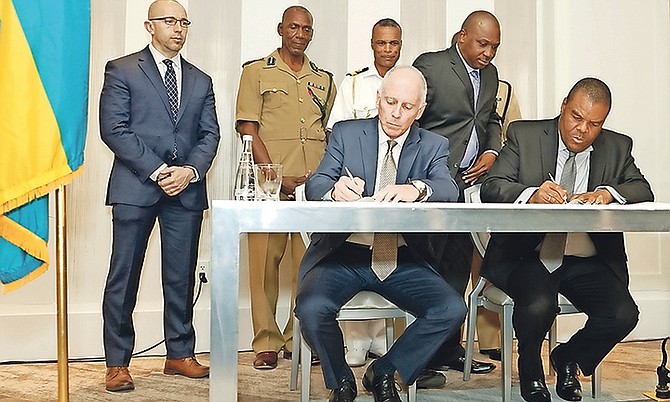Left, Gary Bunyard, senior vice president, and Eugene Poitier, acting permanent secretary of national security, sign the contracts.
By RASHAD ROLLE
Tribune Staff Reporter
rrolle@tribunemedia.net
LAW enforcement agencies will begin using gunshot detection technology this year to pinpoint the location of gunfire after the government signed a $1.9 million contract yesterday with a provider, ShotSpotter.
Prime Minister Dr Hubert Minnis and National Security Minister Marvin Dames said the new programme highlights their commitment to modernising crime fighting tools and equipping agencies with the latest technologies.
After the elaborate ceremony, which was held at SLS at Baha Mar, Mr Dames also told reporters the government will likely spend $2m to $4m this year to considerably expand its use of CCTV.
Murders decreased by 25 percent in 2018 compared to 2017 and Mr Dames has declared his desire to record fewer than 90 murders this year.
Gunshot detection systems work by deploying optical and acoustic wave sensors that detect impulsive noises atop rooftops or utility poles. The sensors locate the origin of gunshots and the information is quickly transmitted to law enforcement agencies.
Mr Dames said he has "completed sufficient research" and is satisfied the technology will help reduce the high numbers of gun related violence in the Bahamas.
“There is numerous evidence in the United States where this technology is aiding in the reduction of gunshot violence in high volume crime cities such as Chicago where police are recording double digit decreases in murders and shootings,” he said.
Mr Dames cited a CNN report which credited “data-driven policing” like the gunshot detection technology for murder reduction in Chicago over the past two years. There were 100 fewer murders in that city in 2018 than in 2017. A Fox News report which Mr Dames also referenced quoted Chicago Police Commander Kenneth Johnson as saying ShotSpotter showed the location of gunfire and how many rounds of gunshots were fired, noting that one area of the city, Englewood, saw a 43 percent drop in shootings last year.
The New York Police Department launched a pilot programme using the system in 2015. Two years later, according to the Wall Street Journal, use of the technology was expanded. The NYPD concluded the technology allowed it to respond to shootings it would not have otherwise known about. Up to August 2017, the organisation said 1,740 shootings were detected with the technology, resulting in 61 arrests and the seizure of 31 guns.
Mr Dames said Police Commissioner Anthony Ferguson led a team to Miami Dade to visit the Miami Gardens Police Department last year and saw the ShotSpotter technology in use. The technology will come to the Bahamas by the end of this quarter, Dr Minnis said. It will cost $1.9 million over a three-year period, he added.
ShotSpotter technology is not without its critics. Privacy advocates have questioned if the technology could pick up conversations among people. Its effectiveness has also been criticised by some, with the Fall River Police Department in Massachusetts reportedly ending its use of the technology last year after saying it worked less than 50 percent of the time.
"...At the end of the day if we figure this is not working out, because we are going to do our study, if we figure we’re going to move in another direction, it’s not going to cost us the life of the contract to move," Mr Dames said. "We can exit. There is an exit clause in these contracts. That’s the way we do business.”
Gary Bunyard, senior vice president public safety of ShotSpotter, said how agencies respond to the system's data will determine its effectiveness.
“There have been a number of systems deployed around the (US),” he said. “Each agency tracks the efficacy of the system a little bit differently. Obviously we’re providing the role to help the agency determine the source of the gunfire. The real key is how they respond to that gun crime intelligence data, the kind of response the agency applies, the kind of resources that are apply to it so there are a variety of factors behind just the application of the technology that can affect the overall efficacy and performance. A lot of agencies want to track arrests, reductions and homicides, we really discourage them from limiting their view to those types of metrics and instead look more broadly at the effects of outcomes on the communities.”





Comments
Use the comment form below to begin a discussion about this content.
Sign in to comment
Or login with:
OpenID